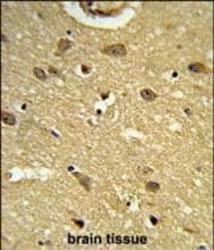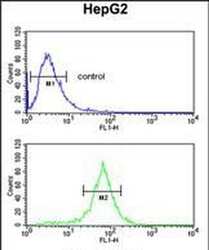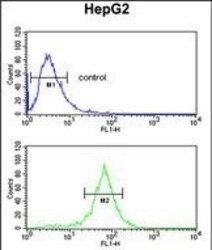Antibody data
- Antibody Data
- Antigen structure
- References [1]
- Comments [0]
- Validations
- Immunohistochemistry [1]
- Flow cytometry [2]
Submit
Validation data
Reference
Comment
Report error
- Product number
- PA5-49644 - Provider product page

- Provider
- Invitrogen Antibodies
- Product name
- UBAP1 Polyclonal Antibody
- Antibody type
- Polyclonal
- Antigen
- Synthetic peptide
- Reactivity
- Human, Mouse
- Host
- Rabbit
- Isotype
- IgG
- Vial size
- 400 μL
- Concentration
- 0.5 mg/mL
- Storage
- Store at 4°C short term. For long term storage, store at -20°C, avoiding freeze/thaw cycles.
Submitted references Ubap1 knock-in mice reproduced the phenotype of SPG80.
Shimozono K, Nan H, Hata T, Saito K, Kim YJ, Nagatomo H, Ohtsuka T, Koizumi S, Takiyama Y
Journal of human genetics 2022 Dec;67(12):679-686
Journal of human genetics 2022 Dec;67(12):679-686
No comments: Submit comment
Supportive validation
- Submitted by
- Invitrogen Antibodies (provider)
- Main image

- Experimental details
- Immunohistochemistry analysis of UBAP1 in formalin-fixed and paraffin-embedded human brain tissue. Samples were incubated with UBAP1 polyclonal antibody (Product # PA5-49644) which was peroxidase-conjugated to the secondary antibody, followed by DAB staining. This data demonstrates the use of this antibody for immunohistochemistry; clinical relevance has not been evaluated.
Supportive validation
- Submitted by
- Invitrogen Antibodies (provider)
- Main image

- Experimental details
- Flow cytometric analysis of UBAP1 in HepG2 cells (bottom histogram) compared to a negative control cell (top histogram). Samples were probed with a UBAP1 Antibody (N-term) (Product # PA5-49644), followed by a FITC-conjugated goat-anti-rabbit secondary antibody.
- Submitted by
- Invitrogen Antibodies (provider)
- Main image

- Experimental details
- Flow cytometry of UBAP1 in HepG2 cells (bottom histogram). Samples were incubated with UBAP1 polyclonal antibody (Product # PA5-49644) followed by FITC-conjugated goat-anti-rabbit secondary antibody. Negative control cell (top histogram).
 Explore
Explore Validate
Validate Learn
Learn Western blot
Western blot Immunohistochemistry
Immunohistochemistry